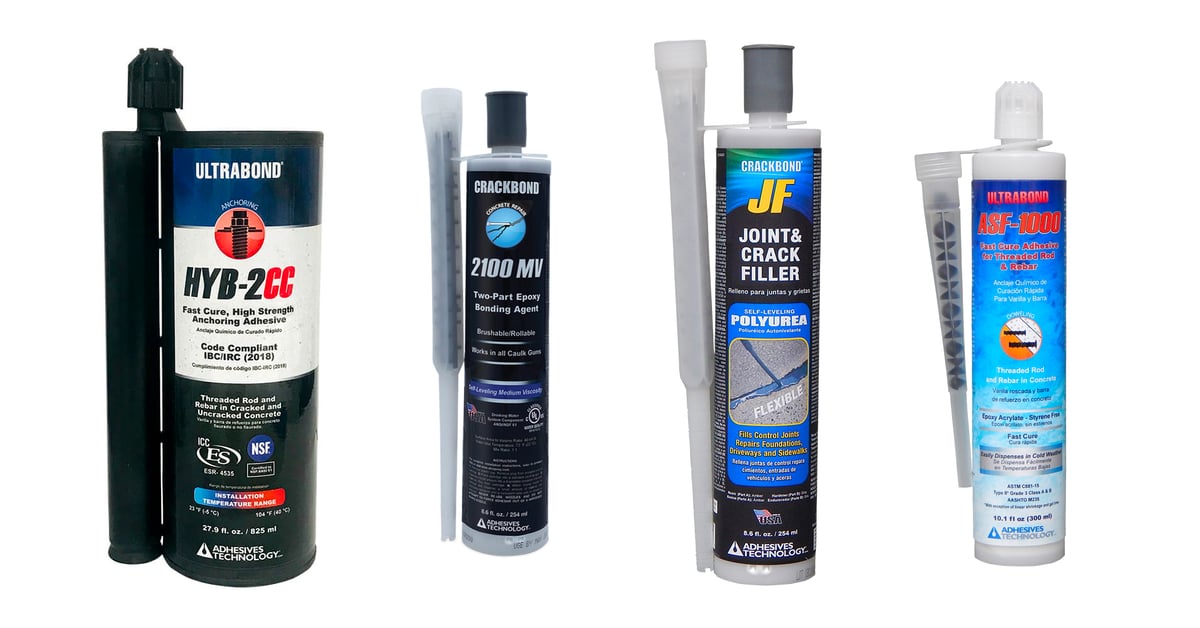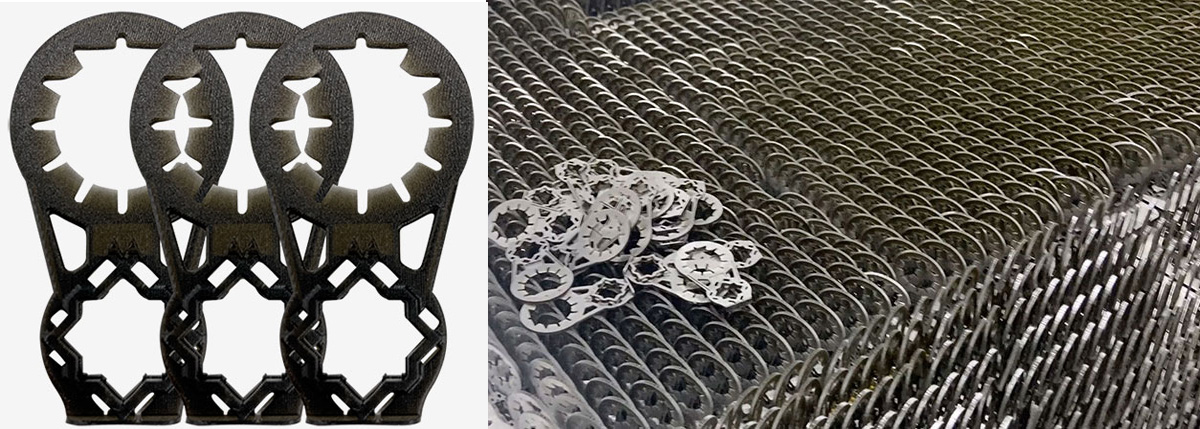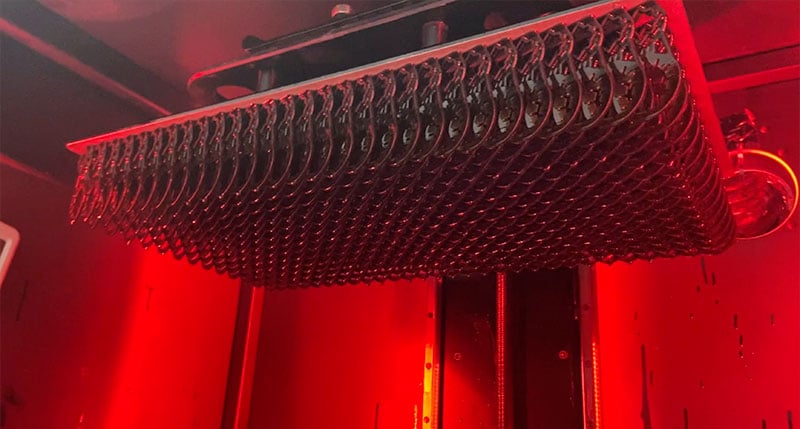Utah-based 3D print service Merit3D is about halfway done with a 1-million-part order from Adhesives Technology, a Florida-based manufacturer of construction and industrial-related adhesive products. How did they land the largest ever 3D printing order, and why was 3D printing the better choice over injection molding? All3DP spoke with Merit3D CEO Spencer Loveless to find out.
It all started with a supply chain disruption.
Adhesives Technology uses custom-designed, injection-molded plastic components to attach two of its related products together. These small hangers, in several distinct designs, ensure that the mixing nozzles stay with their corresponding epoxy cartridges and aren’t separated in shipping or on the retail shelf. Run out of this part, and thousands of orders are stalled.
That’s exactly what happened recently to Adhesives Technology. The company produces dozens of industrial adhesives shipped around the country, but without this simple plastic part, operations came to a near standstill.

Injection molding takes place around the globe, and the most economical suppliers are often in locations where sudden instability can occur — earthquakes, virus outbreaks, embargoes, and sanctions. Reshoring injection molding to the US, however, is time-consuming and expensive. The molding tool used to make just one version of Adheasives’ hanger was a multi-cavity mold, potentially costing hundreds of thousands of dollars to recreate. The more complicated the mold, the higher the cost of the mold tool.
“A connection at Adhesives Technology’s Utah office saw one of our social media posts and reached out to see if we could help,” says Loveless.
At first, the idea was to turn to 3D printing as a stop-gap measure or a potential bridge until new injection molding tools could be created.

Redesign the Part for 3D Printing
Of course, the nozzle hangers could be 3D printed. Merit could 3D scan the hanger, create a digital file, and begin production. But in its current design, the hanger would have been prohibitively expensive to 3D print because not enough of them could fit in one run of the 3D printer. The project would require more printers and, thus, more material and more time.
“There’s a perception that if you have a digital design of a part, you can just switch from injection molding it to 3D printing it,” says Loveless. But that doesn’t usually make economic sense. Just as that original part was designed to be injection molded, redesigning it for 3D printing was the only way forward.
Loveless and his engineers at Merit3D took two weeks to evaluate the purpose and properties of the hanger and redesign it. Through a few iterations, they developed a part that was smaller, lighter, aesthetically pleasing, and used less material to make. More critically, 400 could fit in one print run of their Photocentric Liquid Crystal Magna resin 3D printers, of which they own 24. Each print run takes just under 4 hours. The cost fell dramatically, and Adhesives Technology found its temporary solution.
After receiving an order that would see Adhesives Technology through a few months, Merit3D presented them with another design iteration. This one they called the universal hanger because it would work on two products that previously had distinct hangers. This would eliminate another hanger that Adhesive Technology had to injection mold, ship, store, and apply, plus another injection mold tool that would need to be recreated.

“After we came out with the universal hanger, all of a sudden, their quantity went from x to y, because we just eliminated another SKU that they had to carry,” says Loveless. Adhesive Technology then extended their order with Merit3D.
Even though the 3D printed hangers were more expensive than the injection molded versions, Adhesives Technology was sold on the value-add of continuous innovation and improvement.
“At 500,000 pieces, we’re planning on improving it yet again,” says Loveless. This time, Merit3D plans to take advantage of another 3D printing attribute; the ability to consolidate pieces into one 3D printed part. “Currently, they have a mixing nozzle, a hanger, and a cap as three separately injection molded parts, but our game plan is to see if we can combine all of those into one piece.”
This innovation would save Adhesives Technology even more SKUs.

Is 1 Million Just the Start?
Today, Merit3D is delivering 40,000 parts a week to Adhesives Technology, produced on 10 of their Photocentric printers. Even now, Merit3D is working with Photocentric and its raw material suppliers to find the optimal combination of properties and cost for a new 3D printing resin that will enable them to make more innovations and even thinner hangers that have equal or better mechanical properties than the current one.
Although 3D printing has revolutionized the prototyping space, to compete with injection molding for mass production, it’s a battle of materials. “We’re competing with traditional commoditized plastics like ABS, polypropylene, nylons, and polycarbonate,” says Loveless. “It’s cheap material, and we lose a lot of business because the price of 3D printing material is still too high.”
The photosensitive resins used in the range of 3D printing called vat polymerization are often proprietary. New engineering-grade 3D printing resins are hitting the market regularly, but currently, there isn’t a wealth of options.
“At Photocentric, our goal is to facilitate additive manufacturing solutions that are industrial, scalable, and affordable,” says Sally Tipping, the company’s sales director. “There is still this difference in cost between additive manufacturing and injection molding, but it is very much our aim to bring the cost of the materials down.” Photocentric is an open-material platform, meaning that users can work with materials manufacturers to develop custom resins.

A Turning Tide Toward Additive Manufacturing
Could Adhesives Technology take these part innovations from Merit3D and return to injection molding in the long run? Possibly. But there are forces, both economic and legislative, actively encouraging companies in the US to invest in new technology to reshore manufacturing and a return to “made in America.”
Merit3D took advantage of state-level reshoring grants to purchase equipment and robots that brought the cost of the Adhesives Technology project down.
“We’re very active on that forefront with the United States and the state of Utah to find new ways to reshore manufacturing,” says Loveless. “This is a great example. It is probably the biggest part order ever in the history of 3D printing.”
There’s no doubt that Adhesives Technology’s project with Merit3D is a huge step in the development of additive manufacturing to compete with injection molding.
“The future is untold,” notes Loveless. “Depending on what happens with their mold, and everything else, our goal is to add enough value to the product that they can say, okay, we’re not going to go back to our injection mold.”
License: The text of "At 1 Million Parts, Merit3D to Deliver the Largest 3D Print Order Ever" by All3DP Pro is licensed under a Creative Commons Attribution 4.0 International License.

